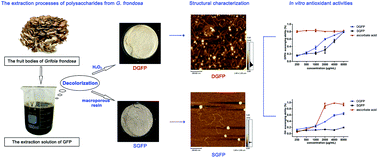Decolourization of polysaccharides is one of the crucial procedures that affects their structure, which is closely related to their bioactivity. Here, Grifola frondosa polysaccharide (GFP) was decolourized with H2O2 and AB-8 macroporous resin. Then, two main fractions, named DGFP and SGFP, were obtained by purification with Sepharose CL-4B. The molecular weights of these two polysaccharides were determined to be 6.306 × 106 (±0.410%) Da and 1.174 × 107 (±0.299%) Da by HPSEC. Monosaccharide analysis indicated that DGFP was composed of glucose, mannose, and galactose (32.20 : 1.00 : 1.75), while SGFP consisted entirely of glucose. Despite a backbone →4)-α-Glcp-(1→ in two polysaccharides, reducing ends Rα →3)-α-Glcp and Rβ →4)-β-Glcp were observed in DGFP by 1D/2D NMR. The results suggested that decolourization with low concentrations of H2O2 might alter the structure of GFP and generate new reducing ends. In vitro antioxidant results implied that DGFP exhibited a higher ability to scavenge DPPH and hydroxyl radicals and reduced the over-generated ROS levels in a concentration-dependent manner. These results suggested that the antioxidant effects of GFP could be activated by decolourization with H2O2. Therefore, DGFP might be a more promising natural antioxidant than SGFP.

